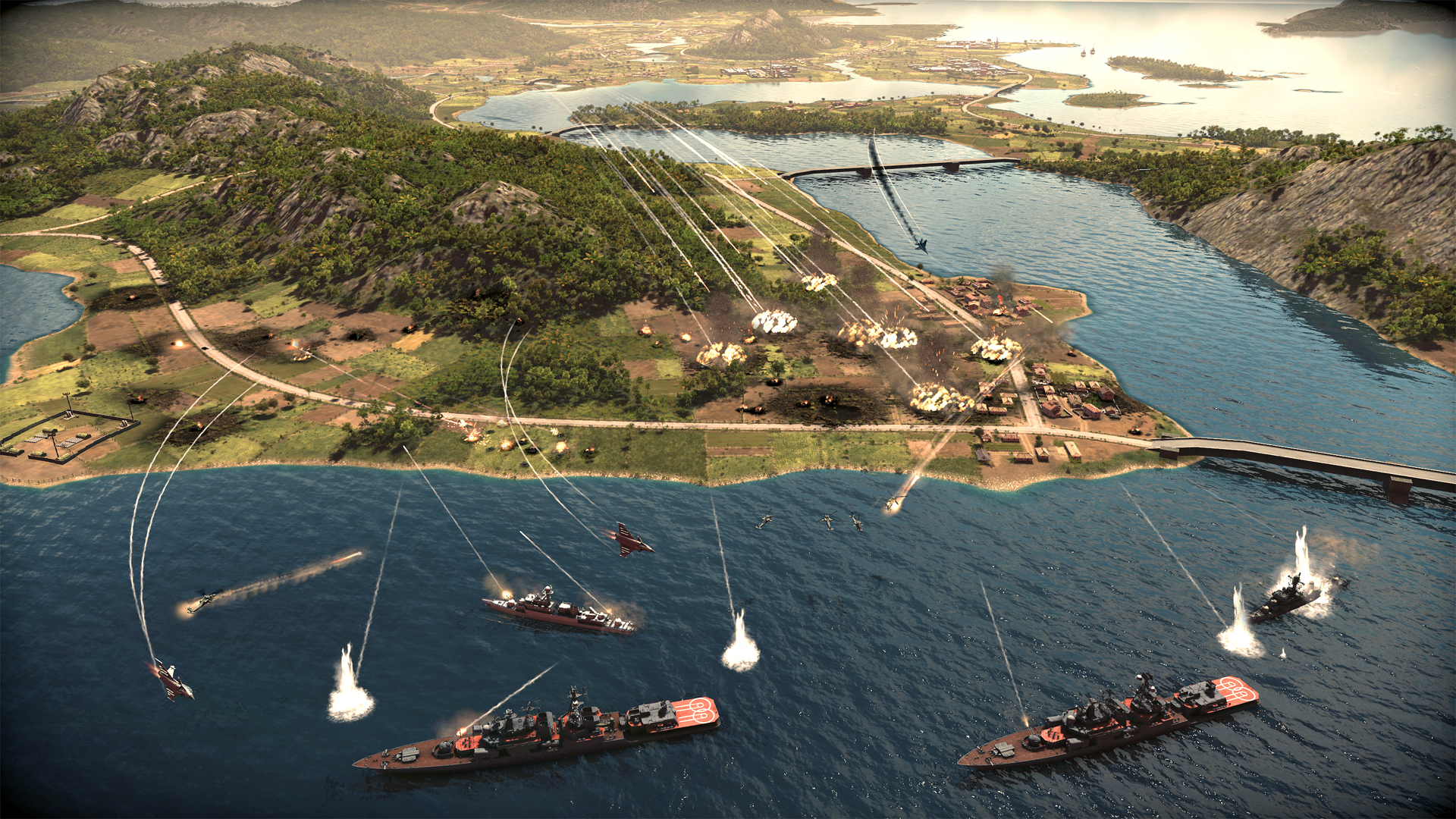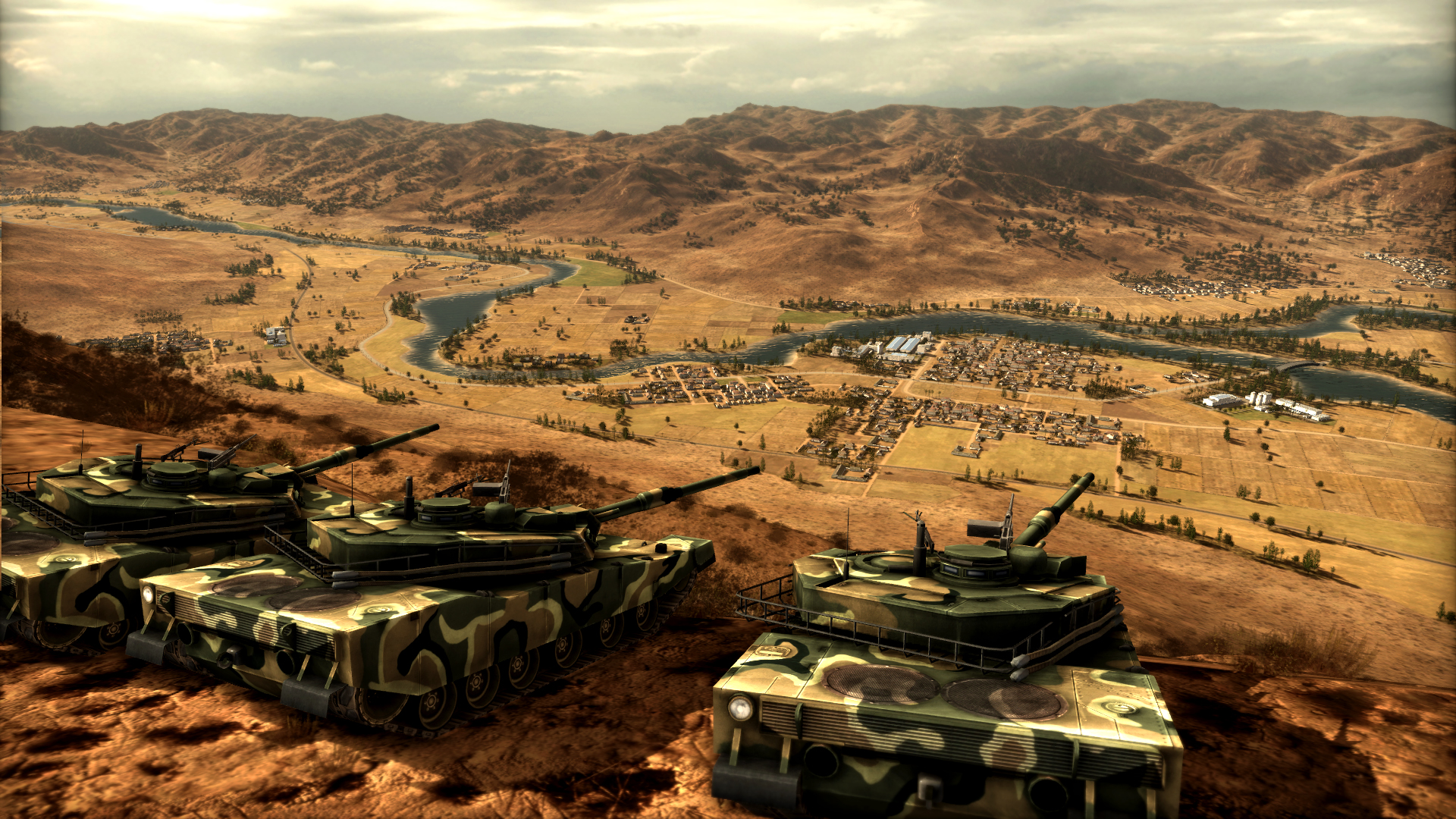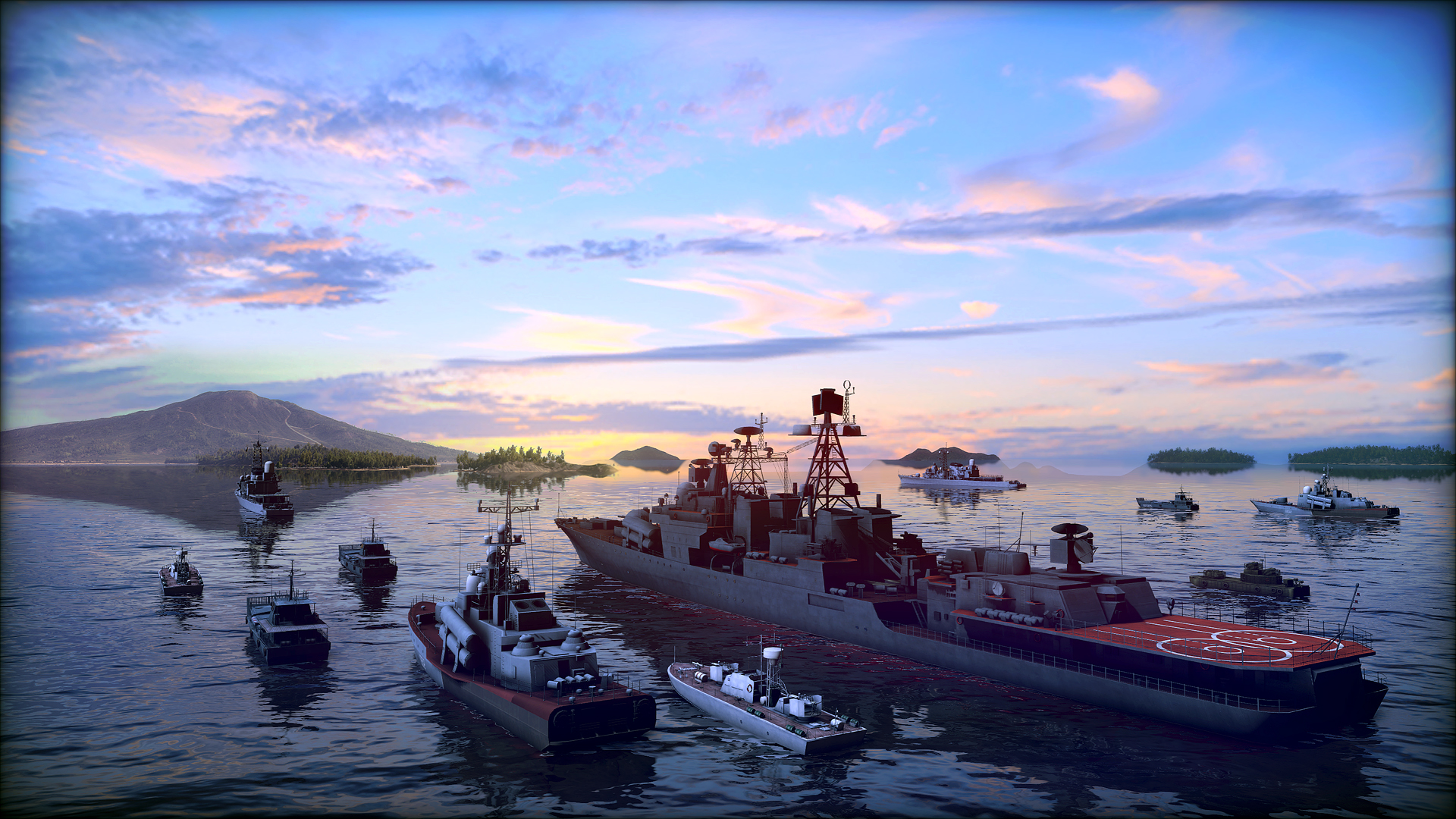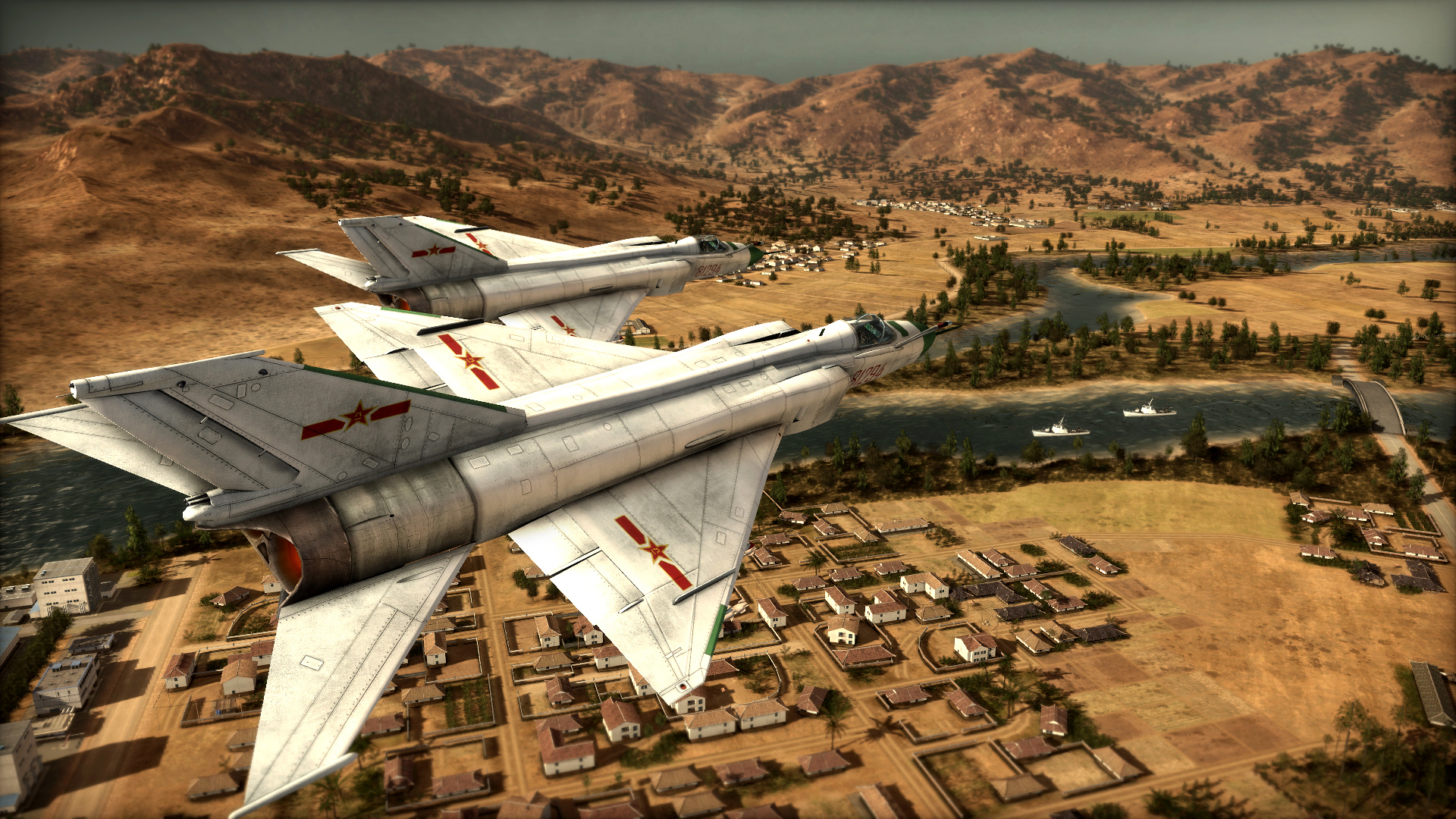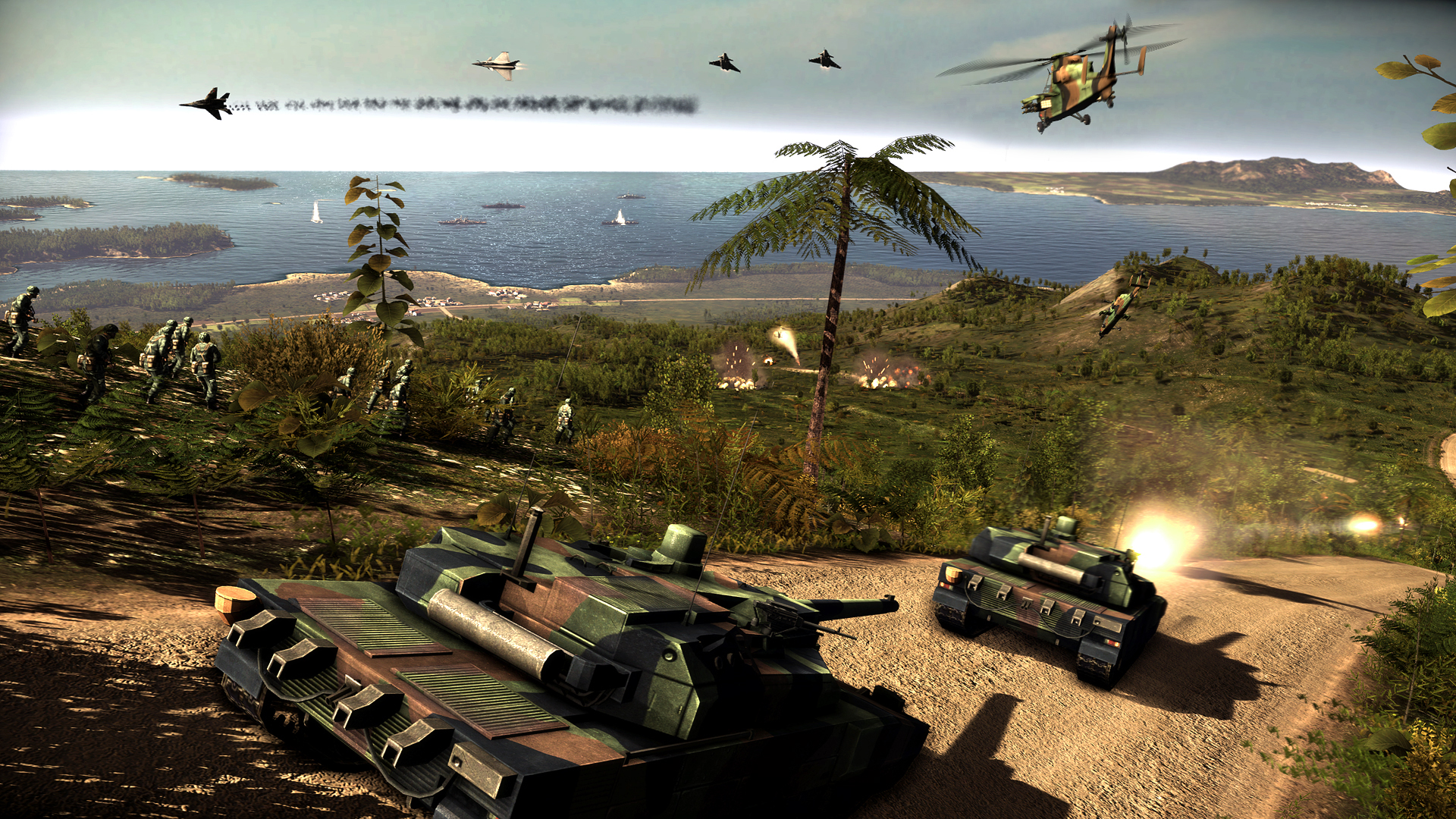The new reference in RTS at its best!
The Wargame series returns to duty, larger, richer and more spectacular than ever before. In Wargame Red Dragon, you are engaged in a large-scale conflict where Western forces clash against the Communist bloc.
1991: the two blocs confront each other in a new theater of war, Asia, joined by various other countries: Japan, China, North Korea, South Korea, Australia and New Zealand.
You command the military resources of all 17 nations involved, assembling your fighting force from a phenomenal selection of 1,450 units that have been meticulously reproduced from their source! Command tanks, planes, helicopters, new warships and amphibious units in intense battles of unequaled tactical depth. Master the relief of varied, ultra realistic battlefields, dominate the new maritime areas and rewrite history in a conflict that has been directed and designed in stunning detail by development studio Eugen Systems.
Wargame Red Dragon is thrilling in single-player mode with its new dynamic campaign system, and also offers an extensive multiplayer mode where up to 20 players can compete against each other simultaneously.
The Wargame series returns to duty, larger, richer and more spectacular than ever before. In Wargame Red Dragon, you are engaged in a large-scale conflict where Western forces clash against the Communist bloc.
1991: the two blocs confront each other in a new theater of war, Asia, joined by various other countries: Japan, China, North Korea, South Korea, Australia and New Zealand.
You command the military resources of all 17 nations involved, assembling your fighting force from a phenomenal selection of 1,450 units that have been meticulously reproduced from their source! Command tanks, planes, helicopters, new warships and amphibious units in intense battles of unequaled tactical depth. Master the relief of varied, ultra realistic battlefields, dominate the new maritime areas and rewrite history in a conflict that has been directed and designed in stunning detail by development studio Eugen Systems.
Wargame Red Dragon is thrilling in single-player mode with its new dynamic campaign system, and also offers an extensive multiplayer mode where up to 20 players can compete against each other simultaneously.
Nation Pack: South African Air Force Showcase
Lets go on a brief tour of history. Fighting with distinction during World War I and II, the South African Air Force (SAAF) really took on a distinctly South African identity in 1950. In that year, the air warfare branch adopted the Springbok in the roundel center. At the same time, the SAAFs first jet fighter - the Havilland DH100 Vampire - was introduced, which soldier on to see service in the early years of the Border War.

In the era that followed, the countrys air warfare branch was bolstered by the arrival of North American Aviation CL-13B Mk VI Sabres, as well as Mirage III, English Electric Canberra light bombers and Blackburn Buccaneer.
Due to the United Nations arms embargo, which ran from the late 70s until 1994, South Africa could not acquire modern weapons or new aircraft. As such, upgrading existing planes or designing new ones - by the local industry - was the only option available to keep a fleet capable and flying.
South Africa, along with Israel, was one of the first nations to understand the potential of the Mirage III, acquiring 16 Mirage IIICZ interceptors between 1962 and 1964 (the Z indicated aircraft specifically supplied to South Africa). The first Mirage fighter squadron was 2 Squadron, the famous Flying Cheetahs, harking back to an illustrious pedigree established during the Korean War.
A follow-up order for additional Mirage IIIEZs was issued even before the original batch of Mirages had made their way to the country. This second contingent deployed in a fighter-bomber role with improved avionics.

Despite its reputation as a superb fighter, the Mirage III lacked the range to make it effective over long distances. This was especially noticeable during the combat, ground-strike, and interdiction missions into Angola, with its remoteness and vast spaces, during the Border War.
The Mirage III heralded the beginning of a love affair of sorts between the SAAF and various Dassault Aviation Mirage variants. For instance, the Mirage III was developed further into the indigenous Cheetah C aircraft, which also used technology from the Israeli IAI Kfir (which in turn was based on the Mirage 5). The Cheetah C evolved into a South African prototype, the Atlas Carver, a modern two-seat, twin-engined multi-role fighter design capable of dealing with the latest generation Soviet fighters. This project ultimately never saw action and was canceled in 1991.
The Mirage story doesnt end here.
The jewel in the SAAF crown was the Mirage F1, as flown by 1 and 3 squadrons. This plane consistently saw considerable action over Angola, shooting down several enemy MiGs. The Mirage F1 was developed as an air-superiority fighter, primarily to succeed the highly successful Mirage III.

Dassaults F1 was a private venture to create a cheaper multi-role aircraft, offering the best operational efficiency with the broadest flexibility. As South Africa began to consider replacements for the Mirage III, the F1 seemed an obvious choice. The F1 offered many improvements over the Mirage III in terms of speed, a general increase in maneuverability, and extended range on ground-attack missions.
The Blackburn Buccaneer fleet would also prove to be a vital component of the SAAF offensive capacity during the Border War. Its low-level strike capacity proved invaluable in hundreds of operations throughout the late 1970s and 1980s.

The Buccaneers often flew with another SAAF workhorse: the English Electric Canberra. The Canberra was a streamlined and highly functional jet-powered light bomber. This fleet saw consistent service throughout the conflict, being used primarily as a low-level bomber force, and was a vital component of the most effective airstrikes of the war.
The principal training aircraft adopted by the SAAF was the Aermacchi MB 326M, with a local variant produced under license by the Atlas Aircraft Corporation and known as the Impala Mk I. An improved version, the Impala Mk II, took to the air in 1974. This small force of Impalas was not only used to train a new cadre of pilots but saw frequent action over the battlefield.

Though slower, they could operate from rudimentary airstrips and deploy quickly, including during reconnaissance missions or in a CAS role. At times, the Impalas were also used as interceptors, shooting down a number of Soviet-made helicopters.
All of these highlighted planes (and variants) will be featured in Wargame: Red Dragon - Nation Pack: South Africa. We are going to take a good look at the SADFs other airborne force - helicopters - in a future blog installment.
Wargame: Red Dragon - Nation Pack: South Africa will feature:
Thats it for now. Well be back in two weeks with even more new details on Wargame: Red Dragon - Nation Pack: South Africa!
Make sure to follow Eugen. Check out our Eugen forums , or (Facebook page and Twitter )!
See you soon!
Hey!
As you know, Wargame: Red Dragon - Nation Pack: South Africa is on its way. Every two weeks, we take a deep dive into a different branch of the SADF as it existed in the 80s during the Bush War. This time, well be detailing the daring flyboys raining death from above: the South African Air Force (SAAF).
Weve already covered two other unit rosters of our new Nation Pack:
- We have put a spotlight on the all-important grunt: SADF Infantry. Read all about it here.
- We also took a look at the SADF Armor force, which you can read more about here.
SAAF leading up to the Border War
Lets go on a brief tour of history. Fighting with distinction during World War I and II, the South African Air Force (SAAF) really took on a distinctly South African identity in 1950. In that year, the air warfare branch adopted the Springbok in the roundel center. At the same time, the SAAFs first jet fighter - the Havilland DH100 Vampire - was introduced, which soldier on to see service in the early years of the Border War.

In the era that followed, the countrys air warfare branch was bolstered by the arrival of North American Aviation CL-13B Mk VI Sabres, as well as Mirage III, English Electric Canberra light bombers and Blackburn Buccaneer.
Due to the United Nations arms embargo, which ran from the late 70s until 1994, South Africa could not acquire modern weapons or new aircraft. As such, upgrading existing planes or designing new ones - by the local industry - was the only option available to keep a fleet capable and flying.
Mirage: a love story
South Africa, along with Israel, was one of the first nations to understand the potential of the Mirage III, acquiring 16 Mirage IIICZ interceptors between 1962 and 1964 (the Z indicated aircraft specifically supplied to South Africa). The first Mirage fighter squadron was 2 Squadron, the famous Flying Cheetahs, harking back to an illustrious pedigree established during the Korean War.
A follow-up order for additional Mirage IIIEZs was issued even before the original batch of Mirages had made their way to the country. This second contingent deployed in a fighter-bomber role with improved avionics.

Despite its reputation as a superb fighter, the Mirage III lacked the range to make it effective over long distances. This was especially noticeable during the combat, ground-strike, and interdiction missions into Angola, with its remoteness and vast spaces, during the Border War.
The Mirage III heralded the beginning of a love affair of sorts between the SAAF and various Dassault Aviation Mirage variants. For instance, the Mirage III was developed further into the indigenous Cheetah C aircraft, which also used technology from the Israeli IAI Kfir (which in turn was based on the Mirage 5). The Cheetah C evolved into a South African prototype, the Atlas Carver, a modern two-seat, twin-engined multi-role fighter design capable of dealing with the latest generation Soviet fighters. This project ultimately never saw action and was canceled in 1991.
The Mirage story doesnt end here.
Air superiority
The jewel in the SAAF crown was the Mirage F1, as flown by 1 and 3 squadrons. This plane consistently saw considerable action over Angola, shooting down several enemy MiGs. The Mirage F1 was developed as an air-superiority fighter, primarily to succeed the highly successful Mirage III.

Dassaults F1 was a private venture to create a cheaper multi-role aircraft, offering the best operational efficiency with the broadest flexibility. As South Africa began to consider replacements for the Mirage III, the F1 seemed an obvious choice. The F1 offered many improvements over the Mirage III in terms of speed, a general increase in maneuverability, and extended range on ground-attack missions.
Offensive bombing
The Blackburn Buccaneer fleet would also prove to be a vital component of the SAAF offensive capacity during the Border War. Its low-level strike capacity proved invaluable in hundreds of operations throughout the late 1970s and 1980s.

The Buccaneers often flew with another SAAF workhorse: the English Electric Canberra. The Canberra was a streamlined and highly functional jet-powered light bomber. This fleet saw consistent service throughout the conflict, being used primarily as a low-level bomber force, and was a vital component of the most effective airstrikes of the war.
Training Aircraft
The principal training aircraft adopted by the SAAF was the Aermacchi MB 326M, with a local variant produced under license by the Atlas Aircraft Corporation and known as the Impala Mk I. An improved version, the Impala Mk II, took to the air in 1974. This small force of Impalas was not only used to train a new cadre of pilots but saw frequent action over the battlefield.

Though slower, they could operate from rudimentary airstrips and deploy quickly, including during reconnaissance missions or in a CAS role. At times, the Impalas were also used as interceptors, shooting down a number of Soviet-made helicopters.
All of these highlighted planes (and variants) will be featured in Wargame: Red Dragon - Nation Pack: South Africa. We are going to take a good look at the SADFs other airborne force - helicopters - in a future blog installment.
What will the South Africa Nation Pack bring?
Wargame: Red Dragon - Nation Pack: South Africa will feature:
- Close to 90 new SADF units, including 20 brand-new vehicle models, as well as many new variants. All feature new Afrikaans and South African-accented English voice-overs, aie boet!
- These include the ubiquitous Casspir and Ratel APCs (in numerous variants, from IFV, recon, command, mortar, and even SAM), the Rooikat wheeled tank (including variants and prototypes), Elan (license-produced French AML), Cactus (French Crotale), the only tracked Olifant MBT, many armed variants of locally made SAMIL trucks (Ystervark and Bosvark SPAAG, Valkiri and Bateleur MLRS), to the iconic G6 Renoster self-propelled howitzer.
- The Air Force includes old Buccaneer[/], [b]Vampire and Impala as close-air support, and several French Mirage variants and the locally modified Cheetah as fighter and multirole aircraft. Furthermore, you will find the Atlas Carver prototype, the first full South African prototype plane design that never left the drawing board.
- Helicopters include the French Alouette III, Puma, Super Frelon and their locally produced versions and prototypes such as the K-Car, Oryx and XTP-1 Beta. Youll also be able to deploy South Africas very own attack helicopter design, the badass-looking Rooivalk.
- Infantry will include Bokkop regular riflemen, Parabat paratroopers, SASF special forces, and many more units such as militia, recon, MANPADS, engineers. You will find Portuguese-speaking Angolan UNITA squads, as well as SADFs own 32 Battalion (the Buffalos), as veteran light infantry formation.
- SADF weaponry features imported or locally built R1 and R4 rifles, SS-77 and Mini-SS MG, LRAC and APILAS LAW, but also the more original HK-21, FT5, Inflict and, of course, the iconic Y2 grenade-launcher and NTW-20.
What happens next?
Thats it for now. Well be back in two weeks with even more new details on Wargame: Red Dragon - Nation Pack: South Africa!
Make sure to follow Eugen. Check out our Eugen forums , or (Facebook page and Twitter )!
See you soon!
[ 2021-04-29 07:26:25 CET ] [Original Post]
Minimum Setup
- OS: UBUNTU 12.04 LTS 64bits/UBUNTU 12.10 64bits/SteamOS 64bits
- Processor: AMD/INTEL DUAL-CORE 2.5 GHZMemory: 2048 MB RAM
- Memory: 2048 MB RAM
- Graphics: 256 MB SHADERS 3.0 COMPATIBLE. ATI RADEON X1800 GTO/NVIDIA GEFORCE 7600 GT/INTEL HD 3000 OR HIGHERNetwork: Broadband Internet connection
- Storage: 20 GB available spaceAdditional Notes: INTERNET CONNECTION REQUIRED FOR ACTIVATION AND ONLINE GAMING
GAMEBILLET
[ 6487 ]
GAMERSGATE
[ 1519 ]
MacGamestore
[ 2422 ]
FANATICAL BUNDLES
HUMBLE BUNDLES
by buying games/dlcs from affiliate links you are supporting tuxDB

